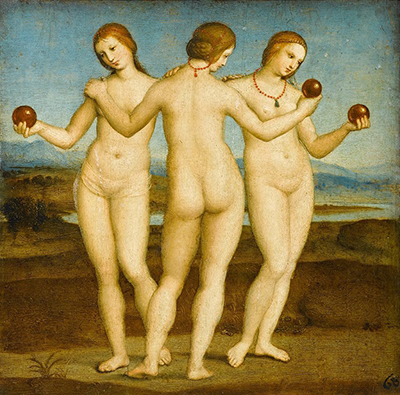The Three Graces is an oil painting by Raphael, currently housed in France at the Musée Condé in Chantilly.
Although the exact date of origin is not known, it is thought to have been painted after the artist studied with Pietro Perugino, and is generally accepted to have been completed when Raphael was an older teenager, between the years of 1503 and 1505.
The piece was painted with oil on canvas and is square in shape, with a dimension of 6.7 inches by 6.7 inches.
The painting displays the three Graces, figures from Greek mythology, thought to represent beauty, creativity, and fertility. Raphael paints the three women in the nude (believed to be the artist's first depiction of the nude female form in both front and back views, lightly embracing each other. The three women, two of which wear necklaces, are each holding spherical objects. See also Three Graces by Peter Paul Rubens.
While some believe them to be apples (perhaps the golden apples from the Garden of the Hesperides?), closer inspection suggests that the flawless spheres are more likely to be golden orbs. It has been suggested that, through these golden orbs, Raphael is connecting the Graces with the moon, the goddess Venus and the planet Venus - further highlighting the connotations of beauty, femininity, and fertility.
As one of the artist's earlier works, it comes as no surprise that the painting lacks some of the exquisite detail of his later work. Indeed, modern art critics have suggested the work lacks some of the care of the artist's later pieces, believing The Three Graces suffers some crude brush strokes, most noticeable in the comparatively imperfect features of the facial profile of the Grace stood in the middle of the painting. Still, this is a defining piece of the artist's early work.
The painting is often posited as being based on a ruined marble statue on display in Siena cathedral, although this is disputed. It has been argued that the painting was in fact inspired by the school of Ferrara, a group of artists whose work is known for a blend of influences from places like Mantua, Venice, and Florence, and has no relation to any known sculpture.
The style of the background of The Three Graces has been compared to Leonardo da Vinci's Mona Lisa (which was painted around the same time), as they are both done in what is known as sfumato, a Renaissance painting style associated with a misty or blurry smokiness. In contrast to the beautiful Graces, the backdrop is quite bleak, serving as a direct contrast to Botticelli's 1482 depiction of the Graces.




